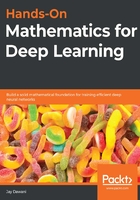
Conditional probability
Conditional probabilities are useful when the occurrence of one event leads to the occurrence of another. If we have two events, A and B, where B has occurred and we want to find the probability of A occurring, we write this as follows:

Here,  .
.
However, if the two events, A and B, are independent, then we have the following:

Additionally, if  , then it is said that B attracts A. However, if A attracts BC, then it repels B.
, then it is said that B attracts A. However, if A attracts BC, then it repels B.
The following are some of the axioms of conditional probability:
 .
. .
. .
. is a probability function that works only for subsets of B.
is a probability function that works only for subsets of B.  .
.- If
 , then
, then  .
.
The following equation is known as Bayes' rule:

This can also be written as follows:

Here, we have the following:
 is called the prior.
is called the prior. is the posterior.
is the posterior.
 is the likelihood.
is the likelihood. acts as a normalizing constant.
acts as a normalizing constant.
 symbol is read as proportional to .
symbol is read as proportional to .
Often, we end up having to deal with complex events, and to effectively navigate them, we need to decompose them into simpler events.
This leads us to the concept of partitions. A partition is defined as a collection of events that together makes up the sample space, such that, for all cases of Bi,  .
.
In the coin flipping example, the sample space is partitioned into two possible events—heads and tails.
If A is an event and Bi is a partition of Ω, then we have the following:

We can also rewrite Bayes' formula with partitions so that we have the following:

Here,  .
.